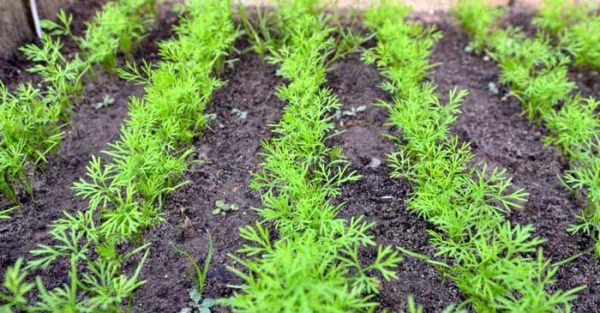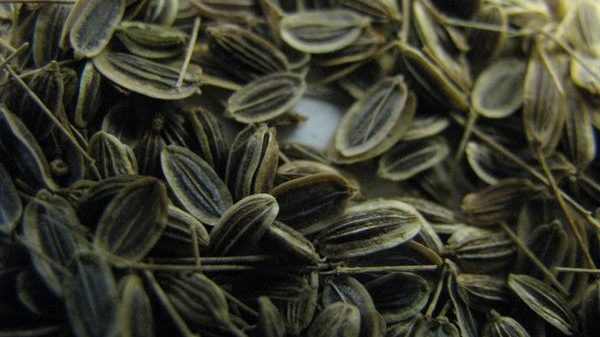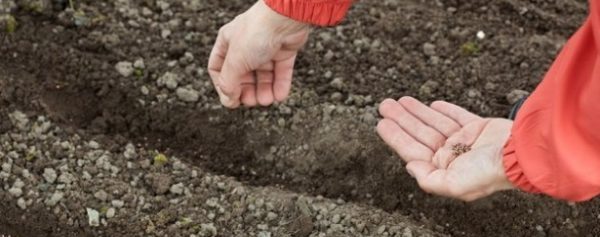Preparation and planting of dill in open ground with seeds
Content
Seed preparation
To get the lush greens of alligator dill as early as late spring, you should prepare some seeds ahead of time before planting. They should be placed in a cloth bag and soaked in warm water with a temperature of +50 C. You need to change the water up to 5 times a day. So the germination of seeds is accelerated and seedlings will appear much earlier. We take the sawdust that has been steamed, pull it out of the water and plant it in the sawdust and leave it for several days at a temperature of +20 C until complete germination and further planting in the soil.
The following described soaking method for alligator dill is slightly different from the previous one and takes less time and preparation. It is necessary to soak for two days in water. Before direct sowing of seeds, they are dried in a dark place.
Video "How to sow seeds correctly"
Demonstration video with examples.
Landing in open ground
Dill cultivation by sowing seeds begins in early spring and before winter. Throughout the summer, the cultivation of dill can be continued by planting alligator dill seeds in order to grow salted umbrellas. Dill grows until the first frosts, but when they come, the plant does not die completely, but simply the foliage becomes unusable. This culture, in self-care, has a negative attitude towards the soil, when it was previously limestone or dolomite flour was added. Seeded dill is not sprinkled with ash and is not planted on acidic soils, it is destructive for him.
The land for planting dill is selected in a sunny area with dug up soil. Half a bucket of humus and compost, about two tablespoons of superphosphate and one tablespoon of potassium sulphide should be added per square meter of soil. All vegetables except celery are good precursors to greens. Seed germination in open ground begins when the air temperature reaches 5-7 C. For winter sowing, the required amount of seeds is not treated or soaked, and this should not be done with spring sowing.
The plant will sprout by itself when the right moment comes or just needs to be planted a little earlier for seedlings. A method is not excluded when you can sow dill for seedlings, the development of the plant occurs quickly. When planting seedlings in open ground in spring, separate sun care is required. You need to plant it in the evening, and create partial shade for the next couple of weeks, for good survival.
Dill cultivation involves two sowing methods: solid or line, it should be borne in mind that solid is more profitable. Per square meter of solid sowing in spring, it is estimated that 15 g of previously treated seeds should be sown.
Growing dill by the line method has its own characteristics for sowing and caring for it.Before sowing, shallow grooves are made, and they are spilled with a solution of potassium permanganate. When the soil is properly prepared, you can sow. It should be planted with seeds with a distance of 5 cm between plants, and for the aisle of sown dill 20 cm. This is done so that in the future the bush greenery is not crowded. Also, dill can be grown between other crops planted in spring, keeping in mind the distance for good foliage development. Every 2 weeks, you can add a couple of rows of dill to harvest throughout the season.
Proper soil preparation for sowing dill in the open field is the introduction of ammonium nitrate (200-300 kg / ha), superphosphate (100-150 kg / ha), as well as potassium chloride. More seeds are applied to light soils than heavy ones. The care plant requires watering 2-3 times a week. Having removed the first crop from the garden, you can still have time to sow 2 times to collect greens.
Growing and care
Cultivation is a necessary procedure in the proper care of the crop; such a process is carried out as needed. But feeding for proper care and a good harvest should be carried out twice a month with ammonium nitrate. If the leaves begin to turn yellow, then the plant lacks nitrogen. In general, dill is a rather unpretentious plant for caring for it.
Watering should be done 2-3 times a week in the evenings and with warm water heated by the sun for the whole day. Loosening the soil is very important in the care. Timely cleaning of weeds is necessary, which can drown out greens. Hilling greens is carried out several times during the growth period. Timely harvesting is also far from the last point in plant care.
Collection and storage
They begin to collect greens as early as 30-40 days after germination. Dill can be collected selectively or by a continuous method. A continuous collection of all plants, selective leaves some of them in the garden. The most valuable young greens, reaching 5 cm, if you do not collect it in time and let it grow, then you need to collect all the plants. Otherwise, inflorescences will begin to form, and the dill will lose its taste.
For pickling, umbrellas are used, which can appear only after flowering, so when harvesting, you can leave a couple of pieces of greenery and collect them in the fall along with the seeds.Dill can reach 1 meter in height. When harvesting, do not uproot plants or simply pick off green foliage.
Seed picking begins in the fall after picking the umbrellas. The inflorescences are stacked upside down in paper bags and stored in a dry, warm place for a week. Such seeds can be sown next year.
The greens for storage are frozen or dried. For freezing, you need to separate the foliage from the stem and wash it well under running water. Lay out on a cloth or paper to dry from water. Then chop finely and place in a freezer container. Such greens are used, if necessary, even in winter.
The drying method involves drying the dill. Drying is carried out both in sliced form and in bundles. The slicing method is similar to freezing, only it is dried up in the end. And drying in bunches involves tying several stalks of dill and drying them qualitatively.
Video "Practical Tips"
Demonstration video about planting dill with practical recommendations.






